Air Combat Force Disbandment Parade
RNZAF Ohakea - December 13, 2001
The material is broken into three sections : pre-display on the flightline, post-display on the flightline , and the parade proper.
The formal ceremony to mark the disbandment of the Air Combat Force was the parading of the Standards of 75, 14, and 2 Squadrons before the Governor General of New Zealand as the Vice-Regal representative. The Standards were then laid up during a service in St Marks, the RNZAF Base Ohakea chapel. The parade was held on the hardstanding in front of the 14 Squadron hangar where a dais for the official party and seating for spectators had been erected. The formal proceedings were scheduled to start at 1410 hours. In readiness the Support Squadrons formed up outside the PTS, and were then marched on. Because Glen was in the Standard party, we knew where the Standards would be uncased - on the small access road alongside the 14 Squadron hangar. I thought this was a particularly special moment. This was a piece of ceremonial I never expected to see.
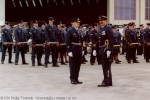

Above Left: The Support Squadrons form up outside the PTS - the officer on the right is W/C Nick
Osborne, CO of 75 Squadron, with W/O Evan Wright, Exec Ops for 75 Sqn. Above Right: The
Central Band of the RNZAF marches on past the Support Squadrons. Below Left: W/C Nick Osborne
has a word with the 75 Squadron Standard Party before the Standards are uncased. Below Centre: The
formalities begin as the Standard Party comes to attention. Below Right: The Escort then 'take guard' as
the Standards are uncased.
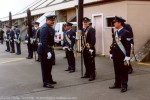
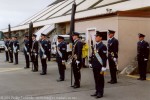
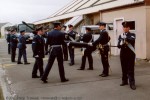
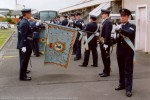
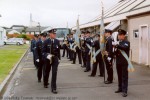
Above Left: The Standards are unfurled. The 75 Squadron Standard is closest to camera showing a
number of Battle Honours. Above Right: With the three Standards unfurled and ready to be raised by the
Standard-bearers, the Party prepares to march on. Below: The action begins as the Party commences to
march on.
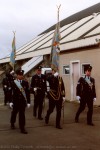
After the Escort Squadron and the Standard Party were marched on, various officials and dignitaries commenced to arrive. The stream seemed to be quite long. The only member of the Government I recognised was the Hon.Mark Burton Minister of Defence. I wasn't sure at first if his appearance was guts or gall, but I suppose he had no choice. The Prime Minister was overseas attending the funeral of Sir Peter Blake.
The arrival of the Governor General, Dame Silvia Cartwright PCNZM DBE, was met by a Wero or challenge. This is part of the process of a powhiri or welcome by which visitors are met. In Maori protocol, when manuhiri (visitors) arrive the challenge is to establish whether their intentions are peaceful. The challenger comes forward (in this case challengers - three warriors in traditional dress) and places a token on the ground (often a piece of foliage but sometimes a carved dart). If the visitor picks this up then all is well - if they trample on it, then there's going to be trouble. No trouble on this ocassion. Once the Governor General was 'welcomed', the Central Band of the RNZAF played the National Anthem for the Vice-Regal Salute. Then the Governor General proceeded to her Inspection.
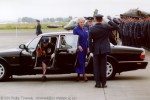
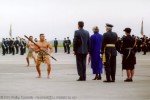
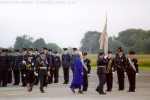
Left: The Governor General Dame Silvia Cartwright PCNZM DBE arrives for the parade, accompanied
by her Aide de Camp F/O Heather Peart who was on a year's secondment from 3 Squadron. Centre: The
challengers come forward as part of the Wero. Right: Dame Silvia and her party acknowledge the 75
Squadron Standard as they inspect the parade.
Once the Governor General had moved to the official dais, the Squadron Standards were paraded. New Zealanders are considered by some to be unemotional people, but I found myself really moved by this ceremonial. Although the RNZAF as a service has its roots in last century, this ceremony of parading the Standard has roots going back nearly 500 years - and it was really something to see it happen right in front of me. Judging by the looks I saw on some of the faces around me, I was not the only one. The laying up of a Standard does not happen often and to see three paraded like this must be unique in RNZAF history. The last squadron disbandment was 1 Squadron in 1984. Prior to that it must be almost thirty years, and that was before any Standards had been presented. (Standards are presented after 25 years service - many of the wartime squadrons did not remain in existence that long).
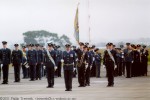

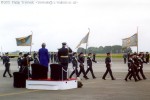
Scenes from the parade - Top Left: Parade Commander W/C Osborne stands in front of the 14 Squadron
Standard. To the rear can be seen the Central Band of the RNZAF. Top Centre: Standards flying - right
to left are the Standards of 75, 14, and 2 Squadron. Top Right: The Standards pass the official dais. Chief
of Air Staff AVM Don Hamilton takes the salute. Below Left: The 2 Squadron Standard is dipped for the
Vice Regal salute. Below Right: Support personal can be seen in front of one of the 75 Squadron aircraft.
An A-4K Skyhawk and a Macchi MB-339 were position on the two corners of the parade ground behind
the support squadrons.
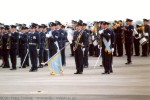
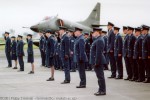
After another Vice-Regal salute to conclude the Parading of the Standards, the formal speeches were held. I noticed that some of the speeches contained a few barbs. Whoever wrote the Governor General's speech had done a good job. It was an eloquent summary of the histories of the squadrons on parade. It was particularly pleasing to hear the battle honours of each being elaborated. Unfortunately there were few Government ears to hear the history that was about to be conveyed to the chapel.
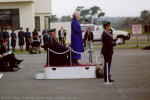
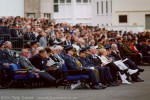
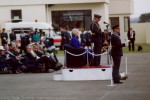
Above Left: The Governor General speaks to the Parade. Note the Leader of the Opposition, the Hon.
Bill English seated to the rear. Above Centre: Various dignitaries seated to the rear of the official dais.
The Defence Minister, the Hon Mark Burton can be seen at the far end of the front row. Above Right:
The Chief of Air Staff AVM Don Hamilton has his say. Below: Members of the service and visitors
look on from the stands.
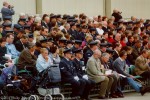
The Chief of Air Staff, AVM Don Hamilton chose to reprise the May 8 announcement in his address. I thought he may have been a touch ironic, or perhaps saved himself from having to put his own views forward. The final speaker who put forward a prayer for the personnel I felt was the most barbed. As she enumerated the various staff involved I think she also spelt out what we were losing. This for me was the saddest moment.

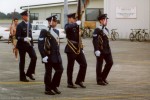
Above left: Above right: Below left: Below right:
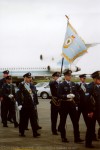
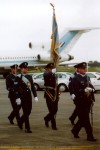
The Escort Squadron then proceeded to march off with the Standards. I followed them as they moved past the PTS on the way to the chapel. The support Squadrons then marched off behind them. The sky which had got increasingly grey as the day progressed, finally opened as the parade finished - talk about raining at funerals. At the chapel they reformed for the service in which the Standards were laid up. Unfortunately the small size of the chapel restricted attendence to the official party and invited guests only. A video link was provided to a Marquee where afternoon tea was provided. Many stood in the rain outside.
I went back to the car with the programmes, then couldn't find John. Tried the afternoon tea marquee, but it was very crowded. Watched part of the chapel ceremony on the video link. Went for a walk, and eventually found John. Then found Glen's wife Raewyn, and finally found Glen. They pointed out S/L Ian 'Sav' Saville, the skipper of 14 SQN. I went and thanked him for his assistance earlier in the year with getting material for my Macchi walkaround. In the marquee Glen introduced me to a few other people. The strangest experience was watching the Governor General, Dame Silvia Cartwright. It was getting late and one of her minders was obviously impatient for her to get to the Vice-Regal car. But she detoured over to us and had quite a long chat. After she'd gone I realised I should have used my camera (Sometimes I really am a bit slow!)
Not long after, John and I headed away too. On the way back to the car we detoured via the flightline and I got a few more pics - so Glen beat us back to the carpark. We headed away about 5.45pm.
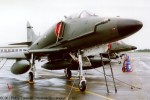
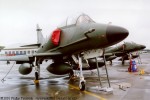
After the funeral - Skyhawks in the rain. Left: A-4K NZ6213 Right: TA-4K NZ6255.
Another slow trip back. We didn't talk as much on the way back as we had on the way there. Stopped for gas in Waiouru, then had dinner at Taupo. It was 11ish when we got back to Hamilton. Had a cuppa, then John was on his way. Bed about midnight. By this stage the whole day had a surreal feeling to it - its not often you see the end of a combat force. It certainly had been a day to remember - and I certainly will!
My View
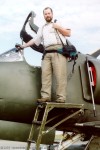 Generally I try to refrain from holding forth with my political views in these pages. The subject is aviation and I try to keep it at that. On the whole that is easy because much of what I have to write is really about history. It' different when you're there as the history happens. However in this case I believe the government of Helen Clark has been wrong and I am very upset at the action they have taken.
Generally I try to refrain from holding forth with my political views in these pages. The subject is aviation and I try to keep it at that. On the whole that is easy because much of what I have to write is really about history. It' different when you're there as the history happens. However in this case I believe the government of Helen Clark has been wrong and I am very upset at the action they have taken.
I am also upset about they way this action has been taken. The government has claimed a mandate based on a little publicised piece their 2000 manifesto. They have then proceeded with what I can only call a campaign of misinformation. I have to say I have been appalled by errors in the correspondence I have had with Members of our Government, and in their public statements regarding the RNZAF - particularly by the Prime Minister. I have personally written to Ministers of the Crown and the opposition pointing out errors, and noting the only explanation for the errors is poor advise or blatant lies. The replies I have received can only push me toward the latter conclusion.
In my view the saddest loss in the disbandment of the ACF is the loss of continuity. Squadrons are formed and disbanded and reformed as needs and roles change. Each time they can hold onto the histories of their predecessors, and their knowledge tends to be moved around, but it is retained somewhere. With the disbandment of this group of people, the RNZAF and the people of New Zealand are losing a set of skills that has taken over sixty years to develop - and those skills are held in the continuity (and to a certain extent embodied in the traditions) of the squadrons. During 2001 I listened to politicians rave on about the brain drain as our skilled people disappear overseas. With the disbandment of the ACF we have Government promoted brain drain. The pilots certainly aren't staying in New Zealand, and a good number of the ground crew aren't either. Over the years we have invested millions in these people and with a single decision the government has thrown it away. From what I hear, Australia is the biggest beneficiary followed by Canada, the UK and Saudi Arabia. The latter country has gained some instructors. If our 'short term thinking' and 'expedient' politicians had used their heads, the set-up at Ohakea was ideal for creating a training ground for overseas countries who wanted to save a few bucks in equipment. We could have carried out the training, and used the income to fund our ACF. This has certainly been to our benefit with 2 Squadron at Nowra in the past few years, where we have supported the Australians. But an anti-military (or at least single-task one eyedness about the military role) has seen the accumulated wisdom of generations thrown away. The argument in regard to saving money becomes irrelevant once you look at the vast sums being wasted elsewhere. This is a particularly bitter pill when the sums of money being thrown at other areas are considered. Anyway, rant off. I suggest you take a look at the Save Our Squadrons website for more information.
Note to Our Boys - and Girls in blue!
I know from email that some currently serving personnel check out my pages, and more than a few ex-service personnel. Although the government has shown it doesn't care, there are a bunch of us out here who do appreciate your work and professionalism. Governments come and go, but the Forces endure - hang in there! Better times will come.
 © 2002 Phillip Treweek, all rights reserved
© 2002 Phillip Treweek, all rights reserved